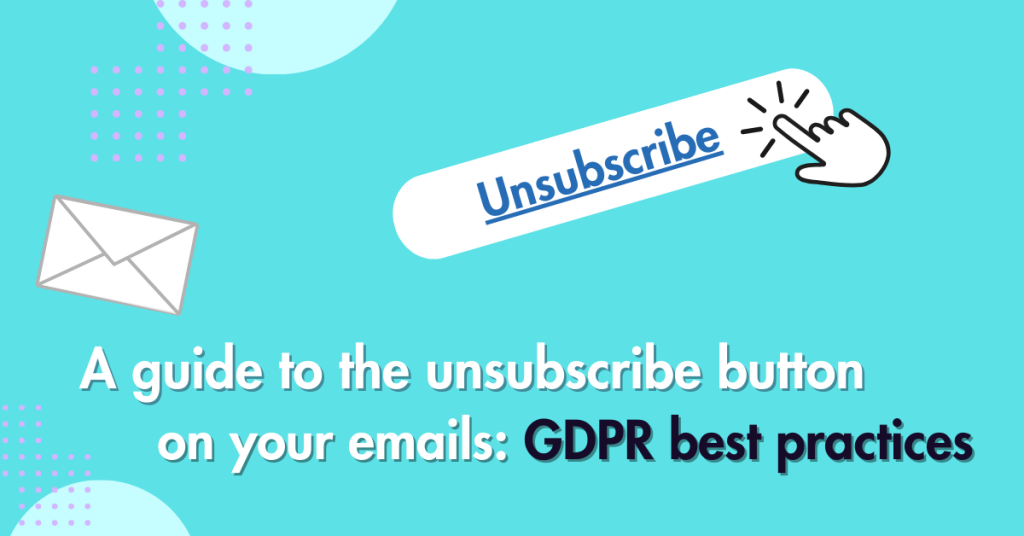
A guide to the unsubscribe button on your emails: GDPR best practices
Imagine a world where marketing emails didn’t have unsubscribe buttons. As consumers, we have the right to decide whether we would like to receive marketing emails from brands we interact with, or buy from. And as businesses, we need to make sure we’re following the rules of GDPR to prevent our emails from going to spam folders and issues with our recipients.
If you’re an email marketer that sends out regular emails to customers and leads, it’s important to understand the legalities and best practices of the unsubscribe option before pressing send on that mass email to everyone in your system.
Keep reading as we highlight some of the most common questions regarding the unsubscribe options and GDPR requirements.
Are marketing emails required to have an unsubscribe button?
Yes, marketing emails are required to have an unsubscribe button. They are required for Business to Business marketing emails, and Business to Customer marketing emails sent from the UK and worldwide. These rules also apply to sole traders.
Is it against the law to not have an unsubscribe button on emails?
Yes, it is against the law to not have an unsubscribe button on marketing emails. According to the UK Gov website and communications regulations 2003, a business must have consent from a consumer to email them, and make it easy for a consumer to opt out of an email communication. Breaching this legislation is against the rights of the consumer and punishable with huge fines. If you have large mailing lists, prioritise following the rules from the country you are sending from (if you’re in the UK, this is GDPR).
For an email, include a clear-to-read ‘unsubscribe’ link anywhere on the email. Requiring a reader to jump through hoops to unsubscribe is considered anti-consumer and could land you in hot water, so keep it simple.
You can optimise your chances of retention by placing it at the bottom of the email to prevent accidental unsubscribes.
How to get recipients consent to add them to your email list
1. A clear invitation
Provide your consumers with an invitation or page to ‘subscribe’ to a marketing communication. With an email marketing platform like Mautic you would be able to see the date and time they provided their contact information, to cover your rights to send them your first email.

2. A purchase from them
If they supply an email upon buying from your company, this is considered a ‘soft opt-in’. But the communications have to be related to their purchase.
Either way, both need to provide an option to ‘opt-out’ in any communication with them, ‘opt’ being another word for ‘choose’.
How consumers don’t consent
If they activate an unsubscribe link, it is clear that they do not consent.
Individuals who have registered their email with the Email Preference Service (eMPS) have also expressed the wish to not receive marketing emails. If you have purchased a marketing list, you should ask the supplier if they are on this list, or can confirm if you have a right to email them. Failure to do so may be a breach in data protection if it’s reported by a recipient that has not given this permission. If a contact has signed up for your mail, it’s reasonable that you should not need to check the eEMPS.
Is the unsubscribe button required with existing customers?
According to GDPR legislation in the EU, e-mail marketing is only allowed without consent for existing customers. But the emails are still required to have an unsubscribe button. To clarify, they must have a chance to opt-out at any time. Even with this option, emails to a soft opt-in customer would need to relate to the product or service that they purchased.
There are exceptions to these rules, where their data is processed for the performance of a contract, and the controller also has to adhere to the data subject’s right to be informed about something critical, or something justifiable in regards to their contract.
What happens if you don't include unsubscribe in email?
If you don’t include an unsubscribe in an email, or if your business breaches the Privacy and Electronic Communications Regulations 2003 (PECR), the Information Commissioner can issue a monetary penalty based on the turnover of the business ona case-by-case basis. In January 2024 it was reported that a food delivery company was fined £140,000 because customers were not fully aware of what they were opting into, and the request for consent included an unfair incentive for them to agree. They were charged with sending 79 million spam emails.
Without an unsubscribe, you will also keep recipients who aren’t genuinely interested in your content and your deliverability rates will go down. You will also not maintain a healthy sender reputation. This could also lead to a broader pool of recipients who are not receiving effective communications, remember, your marketing is a part of the user experience and you will be more likely to receive spam complaints if your content is not relevant.




